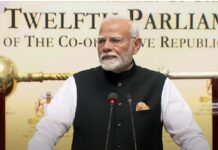Potential of India to rise as a superpower
By Lakshmi Puri
Ever since PM Modi set a developed country by 2047 goal for India, predicated also on its “bigness”, its trajectory so far and potential, international experts have engaged in a discourse on the if and how of India’s ascent to the Mount Everest of great or superpower status.
Latest to do that is the well known journalist whom I have followed since my UNCTAD days in Geneva – Martin Wolf in an Op-Ed titled ‘Why India will become a superpower’ published in The Financial Times on 9 July 2024. Indulging in semantic equivocation, he asserts that India becoming a developed nation when it celebrates 100 years of independence—is “a feasible aspiration, but not a plausible one.”
Feasibility vs Plausibility
The line that best encapsulates Wolf’s thinking on why it’s feasible is “India will be a superpower, not fully matching China and the US, but unquestionably a great power” and that being a “connector country”, India “can and must” shape global economic outcomes. US would still be “more technologically advanced and have far higher productivity” while “India’s manufacturing prowess is also unlikely to ever match that of China.” No one can quarrel with this assessment unless India can pull off a miracle of leapfrogging to overcome the disadvantage of later arrival in the ultimate global trade, investment and technological fast track.
A key factor for his questioning the plausibility of India becoming a ‘superpower’ is that even with the fastest rate of growth and supreme efforts, India’s per capita income(PCI), may only reach 60% of the per capita GDP (PPP) of Greece by 2047, the poorest nation categorised as ‘advanced’ by the IMF -that is around China’s current PCI. China is not a ‘high-income’ country (World Bank), much less an ‘advanced’ economy (IMF) Yet, does anyone seriously doubt its credentials as an economic great power, if not a superpower already?
Criteria of growth
India is on track to meet some key prerequisites he identifies. It is the fastest growing major economy recording twice as much as the increase in global output at an impressive 8.2 % in FY 2023-24 and projected at nearly 7% (IMF) in the near term. India is gaining the required economic weight and volition and has a remarkable record of progress and transformation particularly in the last ten years of the Modi government. with a diversified production base and productivity increasing at double the global average.
As Wolf rightly requires, this growth push is consciously based on its being inclusive, with marked reduction in unemployment and poverty (nearly 250 million Indians exited MDP in the last ten years) and increase in labour force participation. This broad-based high growth is a given, save for unpredictable geopolitical and global economic crises or humanitarian disasters.
Export to flourish
The requirement that Indian exports must grow at least twice as fast if the trade ratio (50%) is not to fall is valid. He warns India “against any renewed bout of aversion to trade”. He regards India’s small share of global exports and historical under-performance as as symptoms of an inward looking shift away from export orientation. That India could do better on exports and close the gap between its endowments – competitive costs, abundance of skilled labour, its fastest growing markets on one hand and export outcomes through business friendly policies is well-recognised and something the government and industry must actively work towards.
Far from signalling export inertia or pessimism, India has grown its manufacturing competitiveness including in Tech 4.0 areas and recorded some of the highest annual growth rates in exports—both goods and services, behind only Vietnam and China, and well above the global average. It has promulgated schemes to incentivise domestic manufacturing for exports and must continue to evolve state of the art trade policies including concluding FTAs for India to become a global supply chain hub.
India’s resolve to achieve ‘Aatmanirbharta’ (self-reliance) in strategic and critical sectors and for essential commodities after the pandemic triggered global disruption to supply chains, does not equal an inward-looking’ trade stance. Like the G7 Western countries themselves have declared, while India is not seeking to decouple or turn inwards, “it is derisking and diversifying supply chains, reducing critical dependencies including those resulting from overcapacity and building resilience to overcome economic weaponization” and benefit from friend shoring.
Unique strengths
Wolf also does not take fully into account India’s unique strengths and fundamentals, Already the third largest economy in PPP terms, it is set to surpass Japan and Germany by 2027. The most populated country in the world, it has the largest youth cohort in history with a potentially formidable human resource reservoir and significant and increasing purchasing power as the middle class expands. With declining fertility rates and given intentional and sustained education and skilling of young men and women, it is poised to reap a huge demographic dividend and leverage its well recognized comparative advantages.
The Stability Factor
Wolf also points to shortcomings in internal and external circumstances and policies that may stymie India’s reaching its goal. He rightly believes that India needs to overcome various “internal challenges” such as “maintaining stability; improving education; defending the rule of law; upgrading infrastructure; providing a first-class environment for investment; encouraging inward investment; and accelerating its shift towards clean energy.” Modi’s India fortunately has shown noteworthy, and in some cases, remarkable, improvements on these aspects and must press on.
In the light of what is happening around us in South Asia, the stability quotient is indeed critical as is our ability to maintain our territorial integrity, build civic nationalism and keep our liberal democracy and needed reforms free from the contagion of destabilization, anarchy and terrorism and what G7 itself vowed to fight – Foreign Information Manipulation and Interference (FIMI) from all sources.
Crucially, as PM starts his historic 3rd term. It is relevant to recall that in a path breaking book “Grasping Greatness: Making India a Great Power”, Ashley Tellis points to the need for sustained political will, focus and confidence of the kind PM Modi alone has shown to envision and pursue India’s greatness. The book also expresses worry about eternally self contesting, litigious democracy with domestic veto wielders and special interests , myopic opposition and regional leaders blocking vital reforms.
Martin Wolf’s orthogonal advise that the BJP government should realign “its efforts on the economy and welfare… rather than on India’s very own culture wars” is unwarranted. The Modi government’s Sabka Vikas focus has always been on economic growth and welfare for all, of all, by all and with all.
Since 2014 it has done more to deliver welfare benefits in India’s independent history than any previous dispensation. From free food to 800 million people to subsidized housing, sanitation, health insurance, education and skilling, energy access and affordability to financial and digital inclusion. livelihood, employment and rural development, Modi’s India has set new benchmarks in welfare.
Big ticket Economic reforms
Big-ticket economic reforms such as the implementation of the GST; insolvency and banking code (IBC); asset monetisation; labour law reforms; Start-up India; and Production-linked Incentives (PLI) have been game-changers in revitalising India’s economy and fostering innovation. The investment-friendly Modi government has done away with 25,000 unnecessary compliances, repealing over 1,400 archaic laws, signalling a non-adversarial policy environment for trade, industry and FDI.
Overcoming Challenges
All this has been achieved despite inheriting a ‘fragile five economy’ and battling various global economic storms and uncertainties, domestic pushback. Its handling of calamitous COVID-19 pandemic in solidarity to support other developing countries which the other great powers failed to do has been exemplary. Russia – Ukraine and other conflicts notwithstanding, it deftly managed to avert the fuel, food, fertilizer and financial polycrisis that hit the Global South.
Challenges remain and India will have to work further to achieve the desired structural transformation, by continuing to hugely invest in infrastructure, skill its large workforce appropriately and provide high-quality jobs, particularly in labour-intensive industries; urbanise inclusively; drive the digital public infrastructure revolution, increase agricultural productivity, enable a green transition; and attract a critical mass of FDI – USD100 billion annually.
India’s Beneficial Rise
India’s rise to leading power status will be different from China’s. It will be benign and beneficial. As the world’s largest democracy, India has demonstrated its ability to unify a fissiparous world, most notably at the 2023 New Delhi Summit of G20 where it shone for its consensus building, and cooperative and mutual benefit ethos. This contrasts with some other great powers coercively furthering their national interests at grave cost to others and reducing international relations to a zero-sum games.
A superpower is preeminent among great powers and is strong and integral to the global order. Now, however, as a multi-polar world takes shape where more countries are increasingly valuing their strategic autonomy, this distinction may be less salient. India seeks to establish its collaborative, sustainable development model as the battle of ideas and systems for a new international order reaches an inflection point. The Global South has already reaped benefits from this approach and expects India to continue to lead on critical areas of global governance.
The Western democracies have the most systemic stake in India becoming a great power by charting a sustainable path to development. If India succeeds, the world wins. India is far ahead of most in setting country targets for the SDGs and Paris Climate Agreement. It proposed one of the shortest time spans between peak emissions and net zero status, established a robust solar power ecosystem, aggressively adopted ethanol blending, other biofuels and green hydrogen, and Prime Minister’s ‘LiFE Movement’ – all a testament to India’s comprehensive green vision and action.
India’s development Utopia may not adhere to notions or income thresholds defined by and for Western economies. But China’s example as of some others who lack in basic social, political and cultural freedoms, shows the deficiency of such metrics in capturing the essence of development or greatness. The India way to economic super powerdom is to have holistic human development at home so all Indians have abundant choices and to be able to drive human centric re-globalization based on Vasudhaiva kutumbakam solidarity.
Credible institutions and experts predict that India will reach a GDP between 26- 55 trillion USD by 2047 and 6-10 times the PCI by then. As the second-largest, technologically evolved economy and market, well ahead of other great powers of today, imagine the tremendous economic clout India will have to be a force for global good! Who wants to quibble about labels ?
About Author:
Lakshmi Puri is a former Assistant Secretary-General of the United Nations and Deputy Executive Director of UN Women; and a former Ambassador of India
















